
views
X
Research source
Most students studying to be doctors, nurses, and pharmacists will study pharmacology at some point. Unfortunately, pharmacology is a notoriously difficult subject because there are hundreds of drugs to study. The good news is that there are tons of effective pharmacology study tips that students use all the time to succeed. Stay organized, work from the top down, and collaborate with your classmates to ace that pharmacology exam you’ve been dreading.
- Study your notes after each lecture to build up your knowledge base over time. Stick to studying 1 subject at a time so you don’t get overwhelmed.
- Write down drug names, types, dosages, interactions, and side effects on flashcards to improve your recall of what they do.
- Study in a group to cut down on study preparation time. You can learn from your classmates and practice teaching concepts they don’t know, too.
Study Tips for Pharmacology

Study your material after each lecture. In pharmacology, cramming is a poor way to study. You will wear yourself out and be exhausted for the exam. A better practice is studying regularly after each lecture session. This helps you build the knowledge over time and avoid feeling overwhelmed before exams. A general study recommendation is that for every hour you spend in class, you should spend an hour studying. This might sound overwhelming, but keeping up with it will save you work in the future. This way, you won’t have to spend all night cramming before an exam.

Study one topic at a time. When sitting down for a study session, don’t overwhelm yourself. Trying to study multiple topics at once will confuse you and your study session won’t be efficient. If you study 3 drug classes in one session, you could get confused and mix up information. Instead, break your study material into specific, well-defined topics and focus on each one individually. Tell yourself, “For the next hour I will study Beta blockers,” and then don’t deviate. Spend that whole study session on that topic so you don’t get confused. Take breaks in between your study sessions. Even if it’s only for a short time, a few minutes of rest can help you return ready for your next session.

Make flashcards. When you start learning individual drugs, things can get overwhelming fast. The best way to keep track of all this information is with flashcards. Take index cards and write the drug name on the front. On the back, add important information like the drug type, dosage, interactions, and side effects. Quiz yourself with these flashcards regularly. You can also purchase flashcards from study companies if you don’t want to make your own. Search online or at your university bookstore for some examples. Carry your flashcards around with you so you can make the most of all your downtime for study. Stuck on the bus? Take out your flashcards!

Make graphs or flowcharts. Visual aids are a huge help in the learning process. Making your own graphs or visual aids not only creates helpful study guides, but the process of making them helps you study as well. For example, you could make a graph that starts with a drug class all the way at the top, flows into smaller drug types, and then finally to individual drugs at the bottom. This organization allows you to get all the information you need at a quick glance. If you don’t want to make your own graphics, websites like Pinterest usually have uploaded graphics and study aids from students in your type of program. If you get graphics from the internet, double-check them for accuracy!

Use mnemonic devices. A mnemonic device is a saying or phrase that helps you figure something out. Medical students use them all the time to help memorize drugs, body parts, and other complex material. Try coming up with your own phrases to remember drug types. It doesn’t matter if they’re silly, they only have to make sense to you. An example of a mnemonic device is that the drug Prazosin ends in “sin” and it is an Alpha blocker. Alpha is God, and God is the opposite of sin. If you don’t want to come up with your own mnemonics, search the internet or ask your classmates for ideas.
Collaborating to Learn Pharmacology

Work with a study group. You and your classmates are all in this together, so you might as well help each other out. Approach some of your classmates and see if they are interested in forming a study group. That way, each person can make graphs, flashcards, and guides for the others to share. This cuts down on the amount of work and makes you feel less alone while studying. Meet with your study group regularly to quiz each other. You could also go over your exams together and talk through what you got wrong.

Teach material to your classmates. The best way to know if you understand something is trying to teach it. When you’ve studied a topic, try presenting the material to your friends, family, or classmates. This tests your knowledge and ability to explain the material clearly. While you can do this exercise with your study group, it may be more helpful to teach someone who isn’t in your pharmacology program. Your classmates probably already know what you’re talking about, but teaching someone who has never seen the material before shows you how well you can break down information and present it clearly.

Ask your professors for help. Remember that your professors are all experts in the subjects they’re teaching. If you need advice or tips on studying, asking them for guidance is always a good idea. They’ve gone through the same education you have and probably developed their own studying strategies.
Organizing Drug Categories
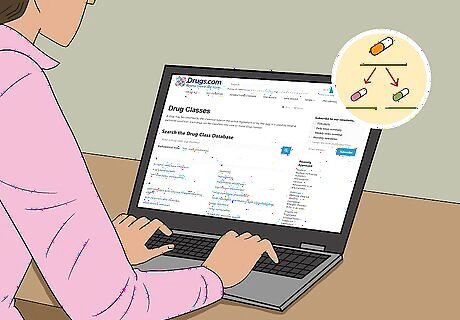
Structure drugs into large classes. When studying pharmacology, start big and work your way down. If you start at the bottom, you’ll be bombarded with hundreds of drugs and be overwhelmed trying to memorize each one. Take the opposite approach and organize from the top down. Divide drugs into large classes with similar characteristics and effects. Then get more specific when you're comfortable with the large groups. For example, there are over 100 antibiotics divided into multiple different categories. Memorizing all of them individually would be overwhelming. Start at the top and organize a general set of “Antibiotics” and then begin learning more specific information as you study. For other large drug categories, visit https://www.drugs.com/drug-classes.html.
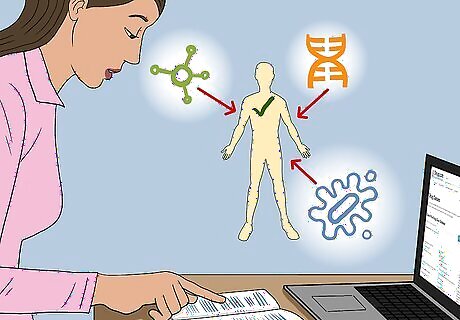
Study how each drug class interacts with the body. A defining characteristic of different drug classes should be their specific effect on the body. Once you’ve identified the large drug sets, start learning general information about each one. How does this drug set work in the body? What mechanism does it use to do this? What conditions do this drug class treat? Fill in this information for each large drug group. Antibiotics, for example, work by fighting bacterial infections within the body. They do not have any effect on viruses. This is all important information to learn about the antibiotic set.
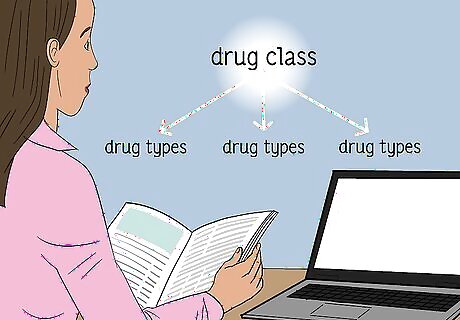
Start learning drug types within larger classes. Once you’ve learned the general characteristics of each drug class, start getting more specific. Learn the drug types within these larger sets. You already know the similarities between these drug types because they’re within the same class, so focus on how each individual type is different from the other. There are 7 main types of antibiotics. They are all similar in that they fight bacterial infections, but each type is more effective against different infections and has different side effects. Study these differences to develop a clear understanding of how drug types within the same class are distinct from each other.
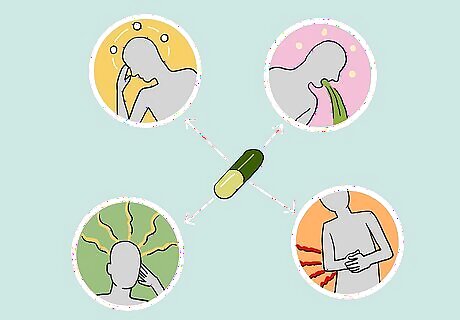
Focus on specific side effects. Don’t try to learn every single side effect of each drug. Almost every drug lists nausea, diarrhea, and upset stomach as potential side effects, so don’t waste time memorizing these. Instead, focus on more specific side effects. For example, if one class of drug lists nausea, diarrhea, and insomnia as potential side effects, insomnia is the important one to remember. The other two are very common and not unique to a particular drug.
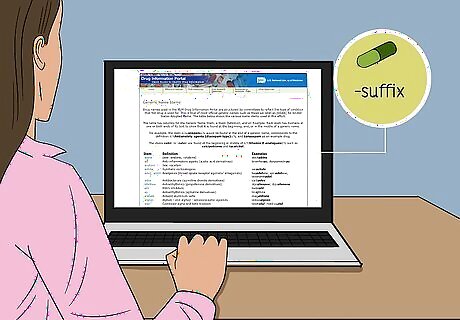
Learn the suffix of drugs. Drugs are usually named in ways that indicate their function. Specifically the suffix, or ending, of a drug name indicates the category it belongs to. Memorize the suffix meanings for each drug category and even if you don’t know a specific drug, you can figure out its function from its suffix. For example, drugs that end in “-pril” are ACE inhibitors, meaning they affect the heart and kidneys. Drugs that end in “-olol” are Beta blockers, meaning they affect the heart, lungs, GI tract, and kidneys. For a comprehensive list of drug suffixes, visit the US National Library of Medicine portal at https://druginfo.nlm.nih.gov/drugportal/jsp/drugportal/DrugNameGenericStems.jsp.

Plug drugs into a spreadsheet. This will all be an enormous amount of information and you don’t want to lose track of it. A good organization tactic is plugging all of this information into a spreadsheet. This keeps all the information in one place and is easily accessible whenever you have to study. List all the relevant information about each drug you have to study. Include class, category, interactions, side effects, dosage, etc. Use this spreadsheet as your master resource while studying. Refer back to it while making your flashcards and study guides.




















Comments
0 comment